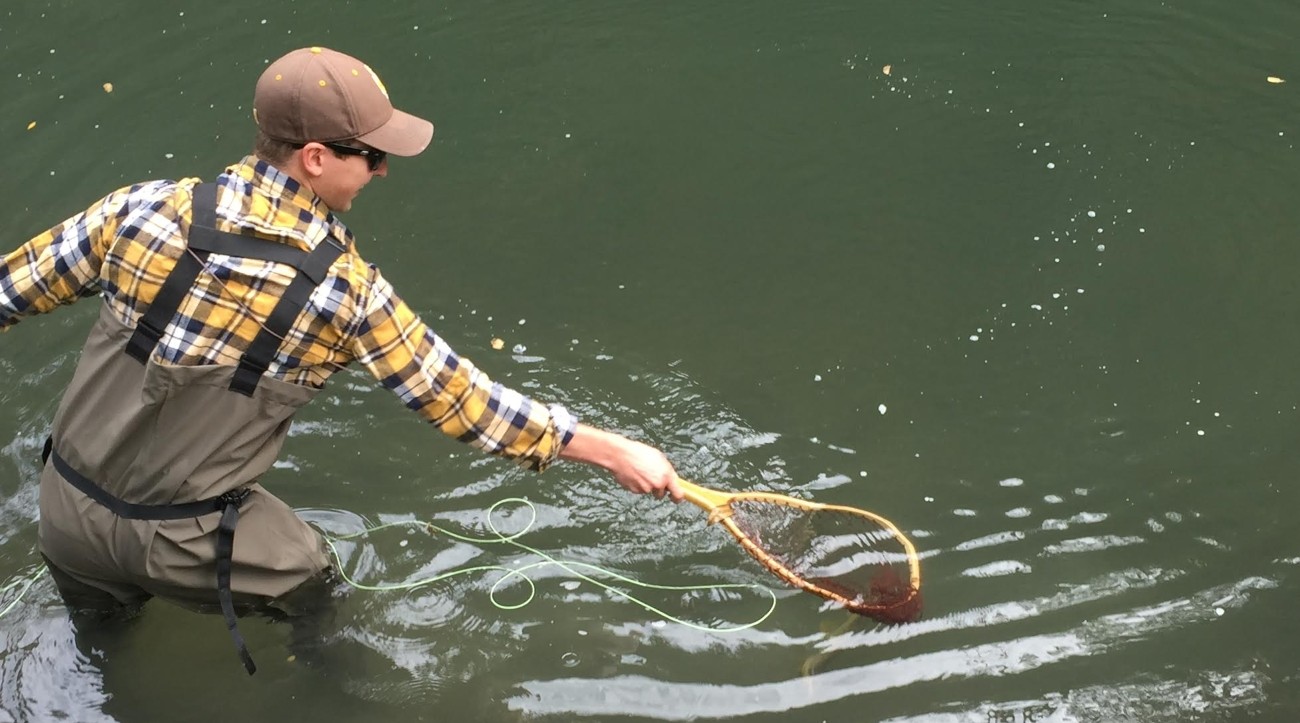This will be every angler's goal Saturday: to net a trout. (Photo by John Weiss)
2025 Trout Season Looks Promising for Local Anglers
SOUTHEASTERN MINNESOTA — Imagine what this Saturday will be like when the 2025 trout season for catch-and-keep fishing opens throughout the region in its hundreds of miles of spring-fed streams. It could again be a time to rejoice that spring is here, catch a few (or many or no) trout, lollygag along streams, share a meal, catch up on family.
If the forecast holds true, it will happen as it has happened many times in the past few decades.
Now, imagine an opener when anglers have to wade through knee-deep snow or could cut holes in the ice on the South Branch Whitewater River and ice fish for trout.
That has also happened, though many years ago.
Minnesota “Spring” Doesn’t Deter Anglers
Over the decades, the opener has changed not only on the date but with drastically different weather. Even now, with mid-April openers, weather can be a real bear, with snow, cold rain, wind and streams high and muddy, or it could be sunny and a breeze to fish. This is spring in Minnesota after all.
Those changes have been accompanied by equally dramatic changes in the streams and trout. Regulations have also changed, especially about 20 years ago with limits put on many streams. More on all those later.
First, how the opener has changed. According to the Department of Natural Resources (DNR), the opener has been in mid-April for about 40 years. But before that, it was March 1, as I recall. One year, snow was knee deep and there was indeed enough ice to go out and chop a hole. Success was marginal on such days. It’s hard fishing with iced-up guides.
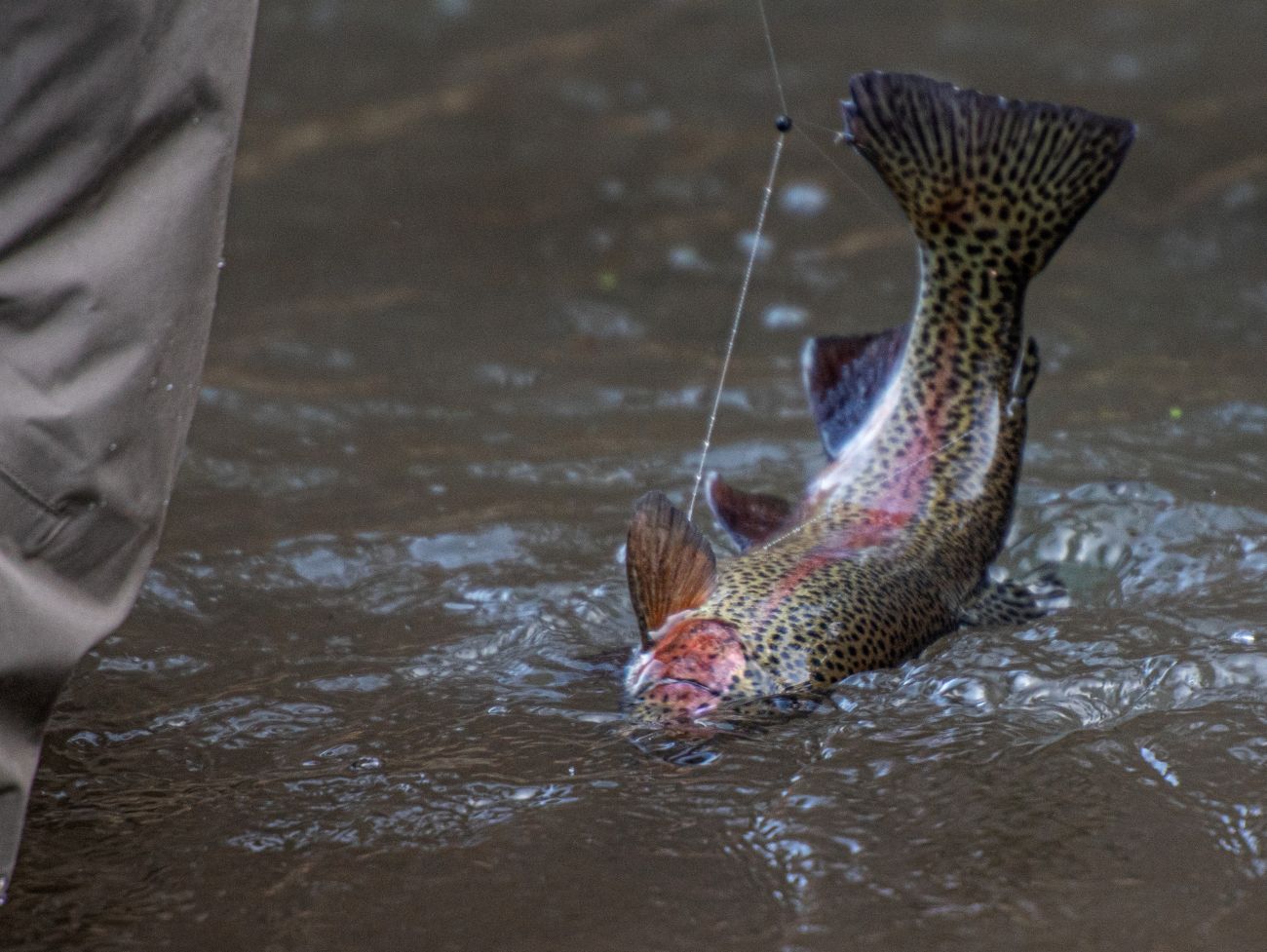
A rainbow trout, stocked by the state, fights after being hooked. Many anglers out Saturday for the regular season trout opener will be looking for this prized fish. (Photo by John Weiss)
Before that, it was in early May according to Lewis Taylor who grew up along Duschee Creek, the stream that flows past the state trout hatchery near Lanesboro. Taylor said it was an exciting time for him as a youth in the 1950s, when he stayed up all night dreaming of trout.
One year, fishing with a cane pole, black fishing line and a worm, Taylor was casting near where Duschee enters the Root River when he had a hit. He fought the fish, a really big one, but the line hung up on a branch. Four or five adults formed a human chain, and one was able to reach the rainbow trout (which had been stocked from the hatchery) just before it got off the hook. It weighed about four pounds.
“I caught that big fish and had to show it off to everybody,” he said.
An Annual Get Together For Young and Old
But here’s another thing he recalls – opening day was a big party, much bigger than it is along that creek today.
“On opening day there used to be cars lined up from the fish hatchery all the way to Highway 16,” he remembers. Just being out “was an adventure in itself…there were tons of people on that creek. It used to get so crowded you’d have lines crossed over each other; it was a regular circus.”
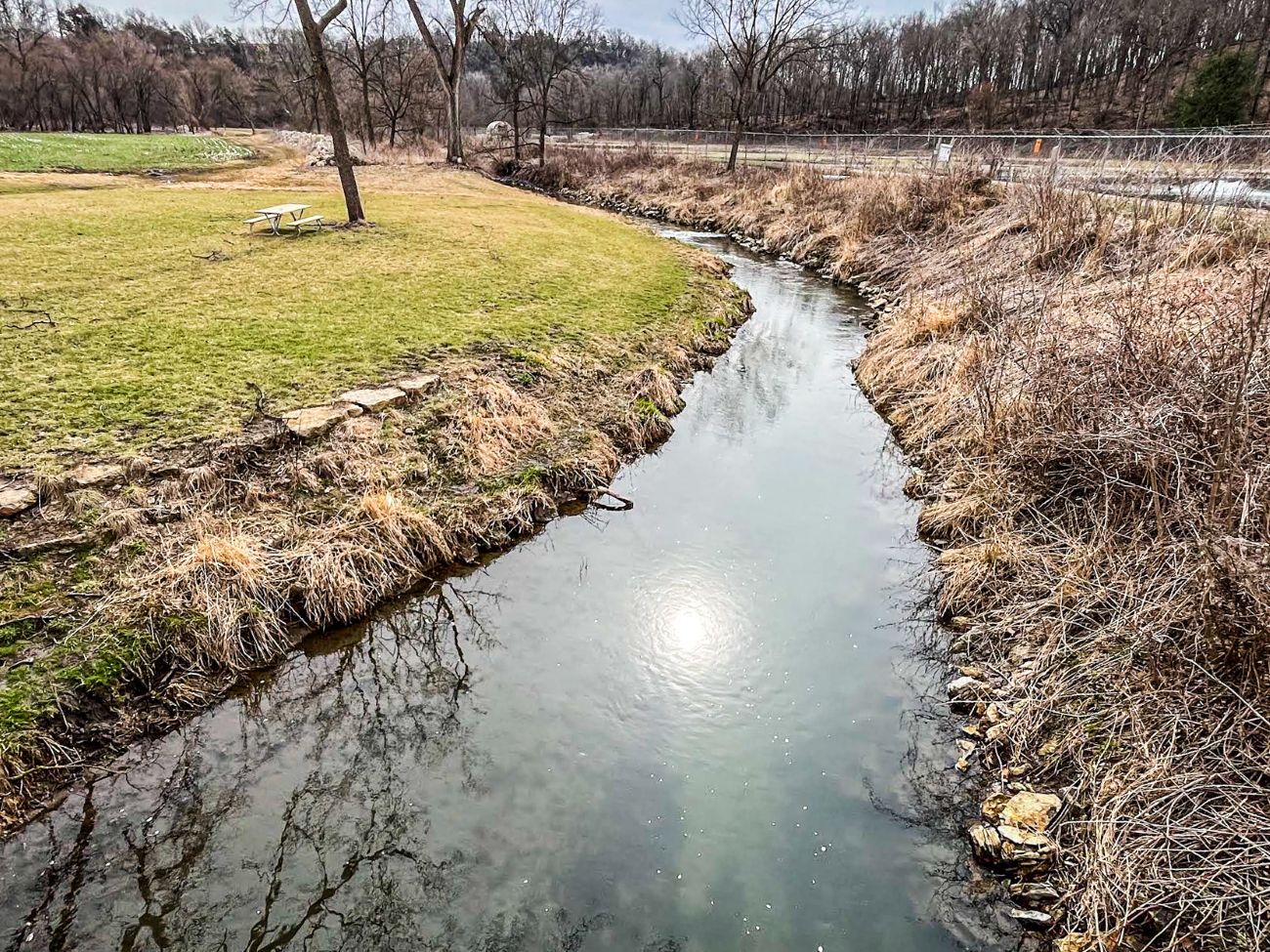
The banks along Duschee Creek near Lanesboro will, if the past is any indication, be loaded with people fishing before sunrise Saturday. (Photo by John Weiss)
Duschee is still a popular place opening day, though not nearly as crowded. People will get to the banks well before dawn to get a good spot. Many have places they have returned to for decades.
It’s the same in Whitewater and Forestville/Mystery Cave state parks. There can be scores of people, often a parent with children, who get there really early for the best spot. Fishing is legal from an hour before sunrise to 11 p.m. so anglers begin casting in the dark, often needing headlamps to tie on new hooks. Anglers do get excited.
That anglers aren’t stacked up along popular streams such as Duschee doesn’t mean fewer anglers are out. There are many more anglers but also many more miles of streams that can be legally fished, so anglers don’t need to crowd just one stream or a park.
Trout Don’t Read Calendars — But Anglers Do
Another huge change is dates when you can fish. Until a few decades ago, trout fishing shut down in mid-fall and opened in mid-April. Trout-eager anglers had to go south into Iowa – yes, Iowa does have trout – for their off-season fix.
Then the DNR began allowing catch-and-release fishing a while after the regular season closed and before the opener. Then it began allowing more catch-and-release fishing – and today, year-round fishing with certain stream restrictions.
Before heading out to a stream, anglers should always refer to the DNR’s annual guidelines. Best advice: get a free DNR booklet that identifies streams, which have easements, and which have special regulations. This information is also on the DNR Fishing Regulations website.

Anglers lined up below the Lanesboro dam in a past opener hoping to catch big trout. (Photo by John Weiss)
When fishing is open throughout the region, only streams on public land or those with easements can be fished. Easements are for fishing only, not picnicking or hiking – even taking a dog along is illegal.
When you fish the regular catch-and-keep season, you have to make one more decision – do you want to keep fish, how big, use live bait or not keep any. The DNR put regulations on some streams so you have to release all fish, those from 12- through 16-inches, or not use live bait.
Yes, it sounds complicated, but most veteran anglers have favorite streams to fish for keeping fish or releasing all. Special regulations are posted along affected streams.
For this year, conditions look favorable for a good opener. A week ago, several larger rivers were a bit fast and very dirty, but they should be a lot better on Saturday.
As for the numbers of trout, it’s looking really good. “Trout numbers are good based on all the (long-term monitoring) data from last year,” said Vaughn Snook, assistant DNR fisheries supervisor in Lanesboro. “We have been stocking Rainbow Trout yearlings this week and will do so next week.”
Big Changes to Stream Conditions Have Changed Angling for the Better
While all the news about seasons, limits and tackle has changed, the biggest news of all about trout fishing is regarding the streams and the trout themselves.
Let’s go back 200 years.
The region was wild with much more prairie but trees along streams. The only trout was the native brook trout.
Because of our karst geology, much of rain and snowmelt seeps into the ground and moves through amazing mazes of cracks, fissures and holes. In the ground, it collects critical chemicals from the limestone. Eventually, it reaches springs and seeps that send the cooled water into the tiny streams and then into larger rivers such as the Root and Whitewater.
But let’s not forget about those chemicals in the water. They are important for starting the food web that goes from plants to tiny bugs such as mayflies and caddis and eventually to trout. The streams are food factories.

This is a caddis, one of the main foods for our trout. They rely on cool water that contains chemicals water picked up underground from limestone. (Photo by John Weiss)
That’s probably the way it was for centuries. Then in the mid-1800s, European immigrants came and found the fertile land. But they farmed it poorly, not realizing how fragile the topsoil was nor how violent our thunderstorms can be.
Much of the topsoil washed into the creeks, rivers and eventually the Mississippi River. What were once cool streams became muddy messes with warmer water. Brook trout suffered and no one knows if native ones survived.
Along the way, brown trout from Europe were brought into the region and released. They tolerate poorer water and basically took over. They continue to be the dominant trout anglers will seek and catch this season, though there are some brook trout (more on that later) and rainbow trout stocked by the DNR.
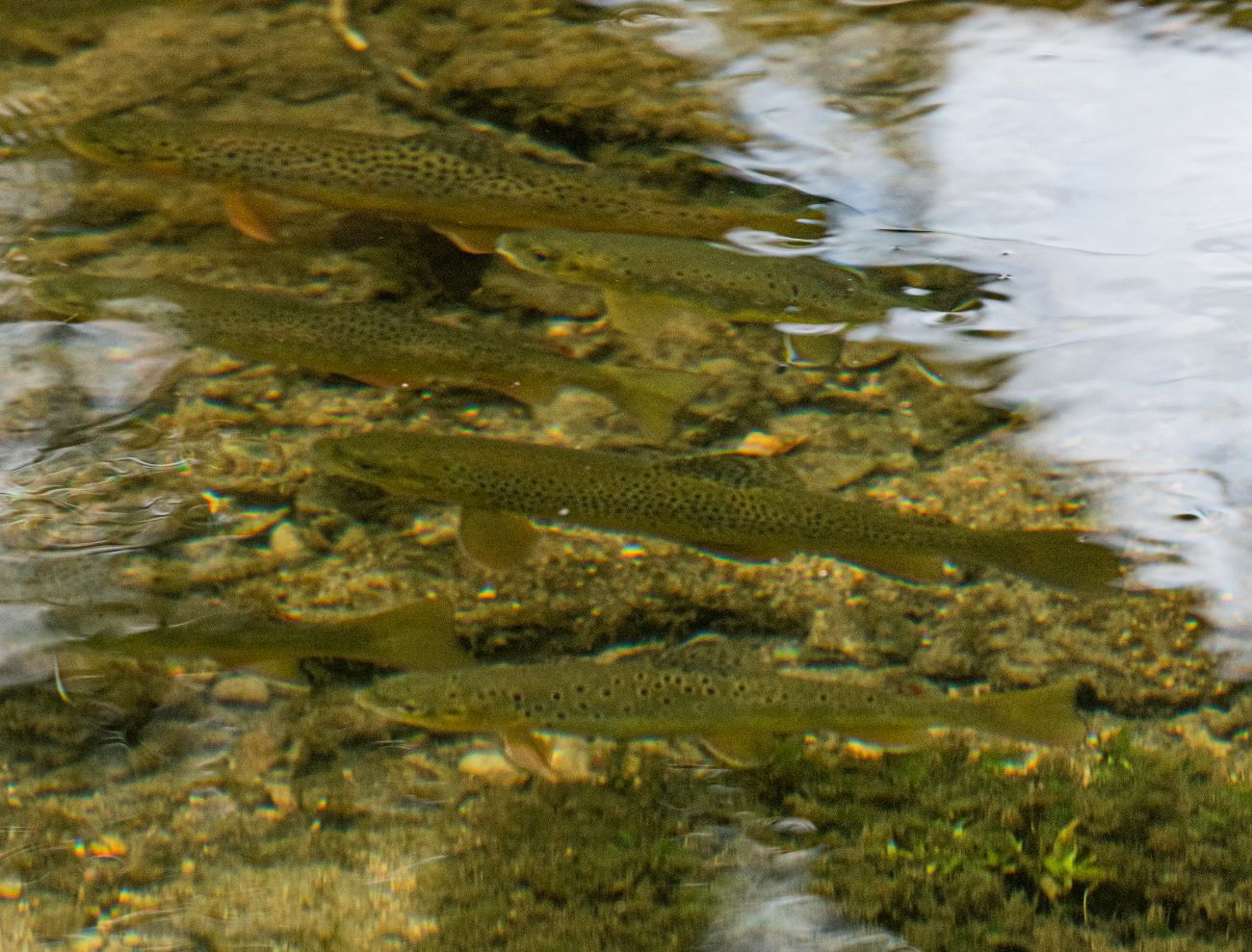
Brown trout are the main fish most anglers will catch during the regular season. (Photo by John Weiss)
Because of degraded streams, the DNR had to stock more fish because spawning riffles were scarce.
Minnesota Conservation Volunteer magazines from the late 1940s and early 1950s told of streams ravaged by such poor land use that dirt covered vital rocky bottoms where trout spawn and where they get a lot of their food.
Trout numbers were low, ranging from 10 pounds per acre to a peak of 200 pounds, with an average of 40 pounds, according to a 1949 article. Many of the fish had to be stocked. The science of habitat improvement was in its infancy.
Today, most trout streams average 200 pounds per acre. Some streams have trout from 500 to low 600 pounds per acre. Most fish now caught are wild fish.
Around 1950, the state had about 25,000 trout anglers compared with several times more that now. The limit back then was 10 fish per day but anglers had to keep all they caught.
Beginning in the era around the 1960s, however, landowners began using better land-use practices, and streams began to improve. And improve and improve some more. More trout were reproducing on their own, stocking tapered down.
A Combination of Conditions Surprisingly Help Area Trout
In the past few decades, the region has experienced three big trout stories.
The first is that climate change means more rain overall and more of the heavy downpours. “Minnesota has warmed by 3.0 degrees F between 1895 and 2020, while annual precipitation increased by an average of 3.4 inches,” according to the DNR.
The increased precipitation has poured more water into the karst landscape and more overall is coming out into existing trout water or is creating new waters where trout might live. You’d think that with warmer temperatures, trout water would be warming but some tests are showing cooler water. That’s because more cool flow from springs, averaging about 48 degrees.
The second interesting story, one that could be showing up this year, is the introduction of the Minnesota Driftless brook trout.
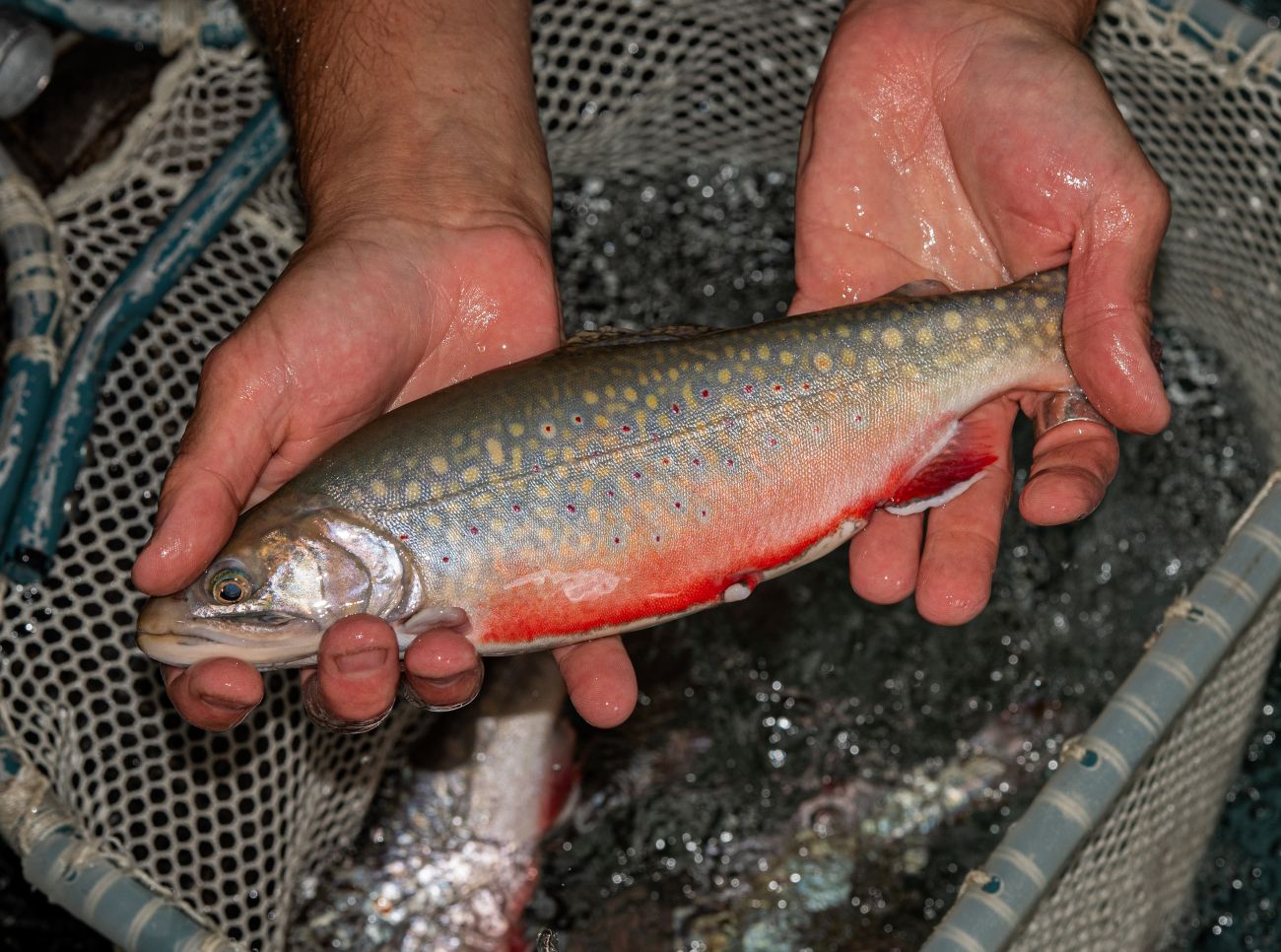
This a Minnesota Driftless brook trout, a new strain that has been stocked over the past few years. (Photo by John Weiss)
Remember that brookies are the only native trout in the region but they were really hurt by the lousy land use. Whether any survived is unknown because we have no DNA from back then.
More recently, curious DNR fisheries researchers began taking DNA from several dozen streams throughout the region. Most of the fish could be traced to hatcheries from outside the state – but then they found three groups of brookies had no DNA that matched any hatchery.
Native fish? Remember, we have no way to prove that, so they are called ‘heritage brook trout’.
A few years ago, the DNR took fertilized eggs from the three groups and combined them to become Minnesota Driftless. In 2023, about 50,000 Driftless brook trout were released into small streams and should be growing.
One interesting observation is that when other kinds of trout, including other strains of brook trout, are released into streams, they seem lost and tend to swim around aimlessly, according to the DNR. But Driftless brookies immediately darted into nooks or under rocks to hide. It seems it’s an instinct.

The state is trying to bring back more slimy sculpins to trout streams because they are a native fish and a great food for trout. (Photo by John Weiss)
Finally, another interesting change receiving more attention, is that years ago avid trout anglers begged the DNR for restrictions that would result in bigger fish for catching (regulations determined what size, if any, trout could be kept). Now, anglers are again begging for more big trout and that has led the DNR to issue guidelines that would have been foreign decades ago: anglers should keep more trout (the regular limit is five with only one longer than 16 inches). The best sizes to keep and eat are 10- to 12-inches.
The problem is that streams and trout are in such good shape that many are overloaded with fish, and streams have only so much food to support bigger trout.
The situation, oddly, is worsened by climate change that has meant many more miles of streams and better water in existing streams. Here’s why: decades ago, streams were warmer so more warmwater bait fish such as minnows, were common. Now, with cooler water, many of those fish are gone from our best waters so big trout, which rely on larger prey and not just aquatic bugs that the smaller trout feed on, have less food.
To help remedy this, the DNR is working at returning more sculpins (mostly slimy) to streams because they are a great food-fish and thrive in colder water.
Admittedly, that’s a lot about trout – but trout are a big part of our outdoors heritage in southeast Minnesota’s blufflands region. Enjoy Saturday.
…………………
Contributor
John Weiss was a full-time reporter for the Rochester Post-Bulletin for 41 years and wrote the Back Roads column for more than 10 years. His passions include hunting, fishing, birding, nature photography, hiking and just kicking around.


